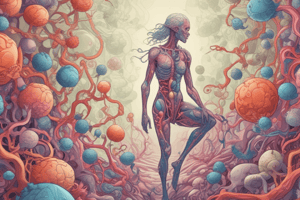Podcast
Questions and Answers
What are the 11 organ systems in the human body and one primary function of each?
What are the 11 organ systems in the human body and one primary function of each?
Integumentary, skeletal, muscular, nervous, endocrine, cardiovascular, lymphatic, respiratory, digestive, urinary, and reproductive systems; each serves essential functions such as protection, support, and regulating bodily processes.
Describe the three sectional planes of the body and their significance.
Describe the three sectional planes of the body and their significance.
The three sectional planes are the sagittal plane (divides the body into left and right), the coronal plane (divides the body into anterior and posterior), and the transverse plane (divides the body into superior and inferior sections). These planes are significant for understanding anatomical relationships and for imaging techniques.
Explain the meaning of 'proximal' and 'distal' in anatomical terminology.
Explain the meaning of 'proximal' and 'distal' in anatomical terminology.
'Proximal' refers to a structure being closer to the point of attachment or the trunk of the body, while 'distal' refers to a structure that is farther away from the point of attachment or trunk.
What is the role of mitochondria in the cell?
What is the role of mitochondria in the cell?
Differentiate between the functions of lysosomes and the plasma membrane in a cell.
Differentiate between the functions of lysosomes and the plasma membrane in a cell.
Flashcards are hidden until you start studying
Study Notes
Organ Systems and Functions
- Integumentary System: Protects the body, regulates temperature, and provides sensory information.
- Skeletal System: Supports the body, protects internal organs, and facilitates movement.
- Muscular System: Enables movement through contraction and maintains posture.
- Nervous System: Processes sensory information and coordinates responses through electrical signals.
- Endocrine System: Regulates body functions through hormones released into the bloodstream.
- Cardiovascular System: Transports nutrients, gases, and waste through blood via the heart and blood vessels.
- Lymphatic System: Defends against infection, maintains fluid balance, and facilitates fat absorption.
- Respiratory System: Facilitates gas exchange, supplying oxygen and removing carbon dioxide.
- Digestive System: Breaks down food, absorbs nutrients, and expels waste.
- Urinary System: Eliminates waste, regulates fluid balance, and maintains electrolyte levels.
- Reproductive System: Facilitates reproduction and the production of sex cells and hormones.
Sectional Planes
- Sagittal Plane: Divides the body into left and right sections.
- Coronal (Frontal) Plane: Divides the body into anterior (front) and posterior (back) sections.
- Transverse Plane: Divides the body into superior (upper) and inferior (lower) sections.
Anatomical Positions
- Lateral: Away from the midline of the body.
- Medial: Closer to the midline of the body.
- Proximal: Closer to the point of attachment or origin of a body part.
- Distal: Further from the point of attachment or origin of a body part.
- Anterior (Ventral): Front surface of the body.
- Posterior (Dorsal): Back surface of the body.
Cellular Organelles and Functions
- Mitochondria: Generate ATP through cellular respiration, providing energy for the cell.
- Cytoskeleton: Provides structure and shape, aids in cell movement, and organizes organelles.
- Lysosomes: Contain enzymes that digest cellular waste and macromolecules.
- Plasma Membrane: Serves as a barrier that regulates the entry and exit of substances in and out of the cell.
- Endoplasmic Reticulum (ER): Rough ER synthesizes proteins, while Smooth ER synthesizes lipids and detoxifies harmful substances.
- Golgi Apparatus: Modifies, sorts, and packages proteins and lipids for transport or secretion.
Studying That Suits You
Use AI to generate personalized quizzes and flashcards to suit your learning preferences.




